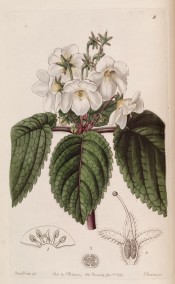Niphaea oblonga Lindl.
Frost-tender perennial with few, ovate leaves, to 7cm, and slender axillary stems, to 15cm, bearing two to several white flowers in winter. [RHSD].
Horticultural & Botanical History
‘Although not to be compared for beauty with the charming Achimenes rosea, or the still more striking A. longiflora, introduced by the Horticultural Society from Guatemala, yet our Niphaea is itself a great acquisition from the same country, where these, and many more species of similar nature were found by Mr. Hartwig. It is the more acceptable because it is one of the few instances of a pure white flower among the Gesneraceous order. In its appearance it is much like Ramonda pyrenaica, but both the form and colour of the flowers are different. In habit it approaches some of the stemless Gesneras. In structure it is very distinct from all the genera of its order yet upon record; from Rytidophyllum, Gesnera, Gloxinia, and Achimenes in the want of a disk; and from Mitraria and Conradia in the rotate corolla. Conradia pumila, a plant I am unacquainted with, may be another species of Niphaea.
Fig. 1. represents the tube of the corolla laid open, to shew the stamens. Fig. 2. is a vertical section of the ovary. Fig. 8. shews the ovary, as seen when divided transversely.
Like many other plants from Guatemala, it seems to require a temperature between that of a greenhouse and stove. In its general habits it resembles Achimenes rosea, described at page 65. It flowers in the autumn and winter, after which the stems die off, and the plant remains in a dormant state until the following season. When in this state it ought of course to be kept perfectly dry, on a light warm shelf, and then when the season of rest is past, which will be indicated by the young stems making their appearance, it may be repotted and liberally supplied with water. It forms a great number of curious imbricated scaly buds, both on the surface and under ground, by which means it may easily be multiplied in the same manner as the Achimenes; it also strikes readily by cuttings. Any rich light soil will do for its cultivation.’ [BR f.5/1842]. It is also figured in Paxton’s Magazine of Botany. [MB p.263/1841]. Introduced to Britain in 1841. [JD].
History at Camden Park
Listed in the 1850 and 1857 catalogues [B.358/1850].
Notes
Published Sep 08, 2009 - 05:14 PM | Last updated Jul 21, 2010 - 04:38 PM
| Family | Gesneriaceae |
|---|---|
| Category | |
| Region of origin | Guatemala |
| Synonyms | |
| Common Name | |
| Name in the Camden Park Record | Niphaea oblonga |
| Confidence level | high |
